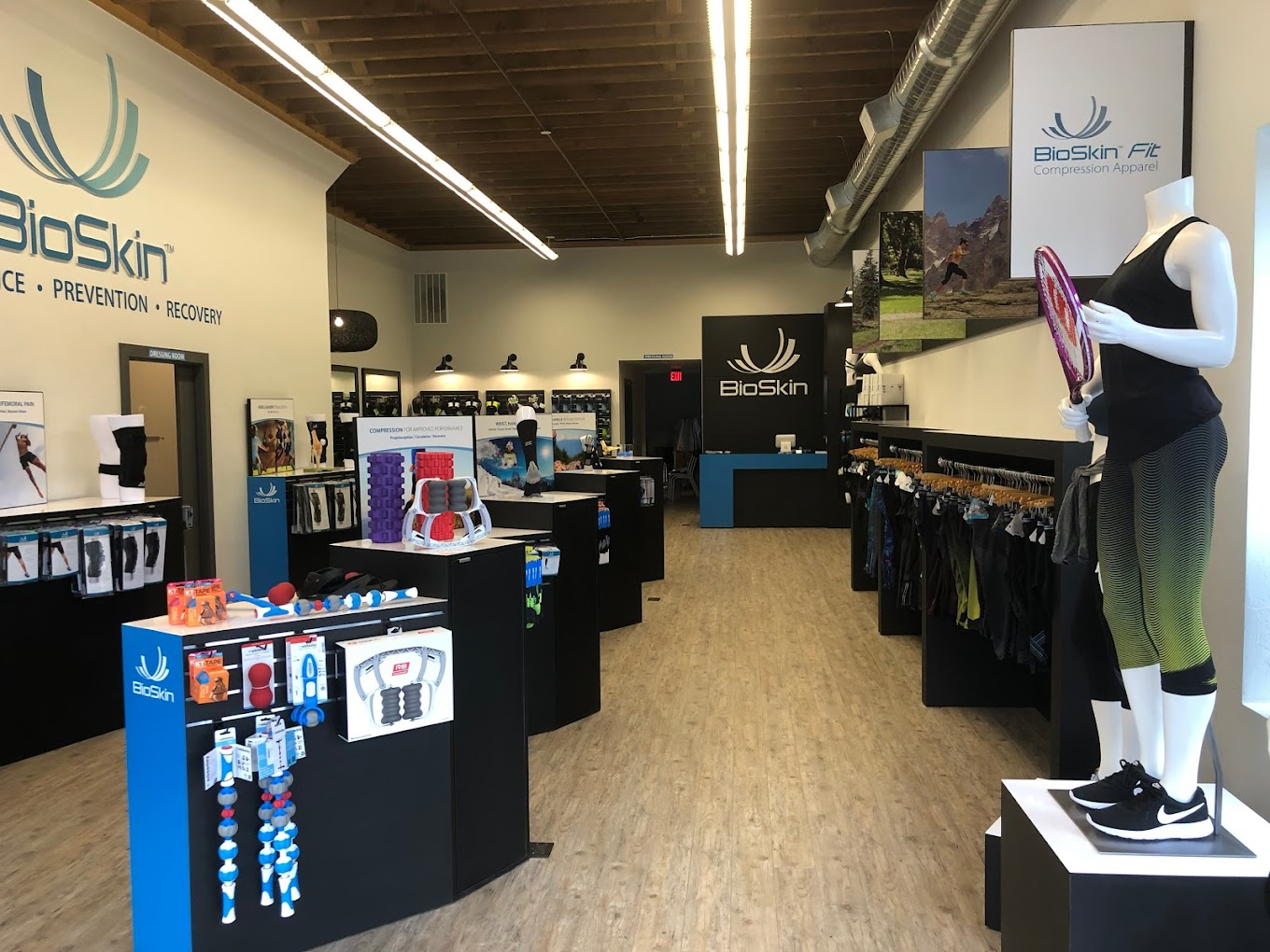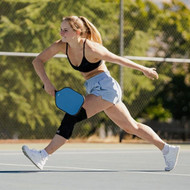Every knee has its own story. Some need extra support after an old injury, others just want more confidence during a workout or a long day on their feet. It's why using the right hinged knee brace matters. The right fit gives you all the stability and protection you need, whether you’re pushing hard in sports or just keeping up with your daily routine.
We’re BioSkin, and this is our guide to finding the right hinged knee brace for you.
Hinge Mechanics 101
At its core, a hinged knee brace is about giving your knee extra control without taking away your natural movement. The hinge is designed to limit risky side-to-side motion while still letting your knee bend and straighten freely.
Many braces use polycentric hinges that track the natural arc of the joint, and some even feature hyperextension stops to prevent the knee from pushing too far back.
Hinges are indispensable during activities that put pressure on your ligaments, such as cutting on the soccer field, pivoting during sports, or navigating uneven ground and stairs. They add lateral support by helping to stabilize the patella and surrounding knee ligaments, so you can stay active with more confidence.
What a hinge doesn’t do
Even the best knee brace isn’t a cure-all. A hinge can’t rebuild a torn ligament or replace proper rehab. It works best as a partner to strength training, mobility work, and physical therapy.
For example, research shows ACL bracing has mixed evidence post-reconstruction, so while it may help protect against risky movements, recovery still depends heavily on exercise and rehab.
Compression and Stability
A knee brace with a hinge stabilizes as well as adds uniform compression around the joint. That gentle, consistent pressure helps calm swelling, ease pain, and provide a sense of security with every step.
For people managing meniscus injuries or general weakness in the knee, the combination of stability and compression can be the difference between hesitating to move and walking with confidence.
Why compression works
Compression improves circulation and helps control inflammation, especially after activity. When paired with adjustable straps, it’s easy to fine-tune the fit for your knee circumference, giving you a custom fit that won’t slip or feel overly tight.
A note on osteoarthritis
If you’re living with knee osteoarthritis, bracing can help reduce symptoms for many people. Results vary, but success often comes down to the right fit, consistent wear, and following simple care instructions like keeping your brace clean and letting it air dry.
Worn properly, compression combined with hinge support can make stairs, walking, and everyday routines much more manageable.
A Quick Pathfinder to Your Knee Brace
The “best” hinged knee brace really depends on how you plan to use it. Your activity level, comfort needs, and injury history all play a role in finding the right fit. Here’s a quick way to narrow down your options:
Court & field sports (Basketball, soccer, pickleball)
Look for slim, lightweight designs that can fit comfortably inside sport sleeves or socks. These braces should emphasize lateral control to stabilize the joint during quick pivots, while keeping the kneecap secure and supported.
Running & hiking
Breathable fabric is the key to avoiding overheating, along with a hinge that won’t chafe against your leg during long distances. An optional patella pad can add extra relief for anterior knee pain that often flares up on hills or uneven terrain.
Strength training & long workdays on your feet
If you’re constantly on the move or need to remove your brace between sets, a wraparound style with straps makes it easy to adjust, tighten, or loosen as needed. These braces balance stability with convenience, so you’re never slowed down.
Post-injury protection (MCL, Meniscus, ACL)
For ligament or meniscus injuries, a hinged brace with adjustable ROM stops offers the controlled protection you need as you recover. These braces are best used under a clinician’s guidance to make sure the positioning and progression match your rehab plan.
Comfort Features That Help with Daily Life
A hinged knee brace shouldn’t just support you during workouts or recovery—it should fit seamlessly into your everyday routine. Here are the comfort details that make all the difference when you’re wearing a brace for hours at a time.
Slim profile
The best braces deliver stability without bulk. A slim design fits comfortably under jeans, workwear, or uniforms, so you get reliable support without feeling weighed down or restricted.
Breathable, hypoallergenic fabrics
Many people find traditional neoprene braces hot and irritating. That’s why we use lightweight, breathable materials that reduce skin irritation and let you wear the brace longer with confidence and comfort.
Easy adjustments
Swelling can change throughout the day, so having top and bottom straps makes it easy to fine-tune the fit. You can measure, tighten, or loosen as needed to maintain comfort and stability without having to constantly remove the brace.
Quick Picks for Sports Scenarios

Different sports put different demands on your knees. Here are a few common situations and the types of hinged knee braces that can help you feel more stable and confident.
Cuts and pivots make me nervous
If quick changes of direction leave you worried about instability, a hinged sleeve with lateral stays and a patella ring adds the right balance of stability and reassurance without slowing you down.
Stairs hurt the front of my knee
For discomfort in the front of the knee during climbing or squatting, a hinged brace with a patellar guidance pad or strap helps keep the kneecap aligned and reduces pain during upward movements.
I’m returning after a sprain or tear
Post-injury, especially with ligament or meniscus involvement, a hinged brace with a clinician-set ROM hinge is the safest bet. It allows you to control the range of motion, stabilize the joint, and gradually progress as your strength returns.
Hinged Support for Everyday Scenarios
A hinged knee brace can make everyday life feel easier and more stable, too. Here are a few ways it supports you outside of sports.
Commute, meetings, and errands
When your day takes you from the office to the grocery store and everywhere in between, a slim hinged design gives you stability without bulk. If swelling changes during the day, adjustable straps make it simple to loosen the brace at lunch and retighten when you need more support.
Parenting, caregiving, or travel days
Carrying kids, lifting groceries, or pulling luggage through the airport puts stress on your knees. A hinged brace adds steady support so you can handle the load and the long walks with more confidence.
Active weekends
From yardwork to hiking trails to playing in your local rec league, the same brace you wear for stability during the week works just as well for weekend activities. The consistency means your knee always feels supported, no matter the setting.
Move with Confidence, Every Step of the Way
A hinged knee brace is about freedom. The freedom to cut, lift, climb, and live your life without second-guessing your knee. It's quiet confidence because it's there when you need it, invisible when you don’t.
That’s exactly what we design at BioSkin. Our hinged knee braces combine stability, compression, and all-day comfort so you can focus on your game, your work, or simply enjoying your day.
Explore our full Hinged Knee Brace Collection, and find the one that fits your lifestyle.
Frequently Asked Questions
What is the best knee brace for sports and daily activities?
The best knee brace depends on your needs. For general support and stability, a lightweight hinged knee sleeve works well. For higher protection—like after a ligament injury—a hinged brace with adjustable stops provides more control.
Can a hinged knee brace help with meniscus injuries?
Yes. Hinged braces add stability and reduce strain on the joint, which is especially helpful for meniscus injuries. They can ease pain during walking and activity while you recover, though they work best alongside physical therapy.
What are the proper care instructions for a hinged knee brace?
Most braces should be hand-washed in cold water and left to air dry. Following the manufacturer’s care instructions helps maintain strap grip, hinge function, and fabric comfort for long-term use.
How tight should a hinged knee brace be?
Your brace should feel snug but not restrictive. If you notice tingling, skin color changes, or slipping, it’s a sign you need to readjust the straps for a secure, comfortable fit.


 US Dollars
US Dollars
